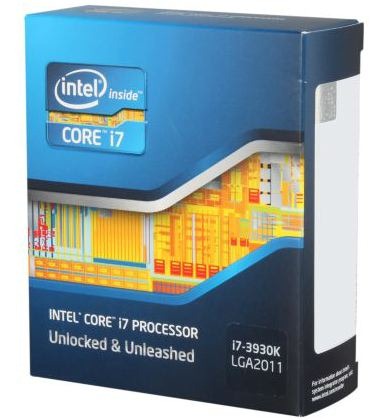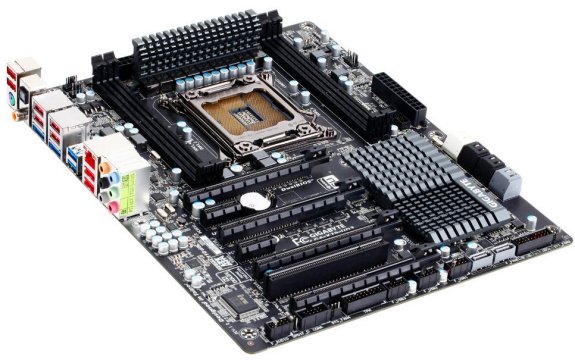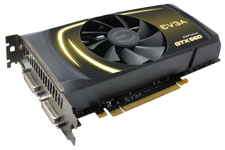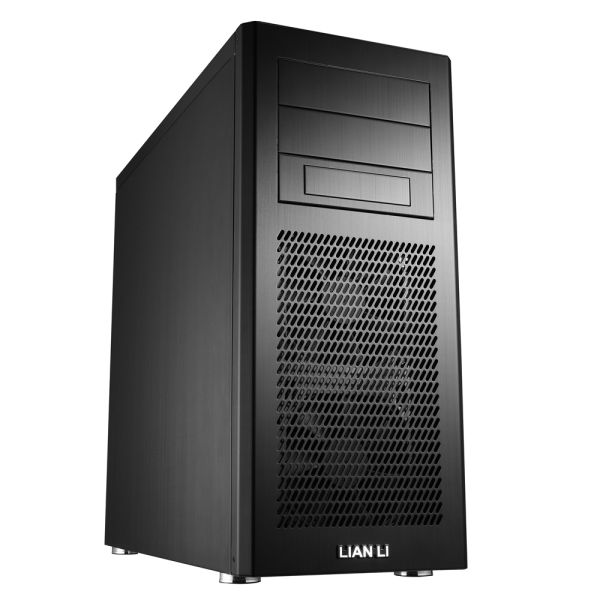Holiday 2011 Mainstream High-End Buyer's Guide
by Zach Throckmorton on December 9, 2011 12:00 AM EST- Posted in
- Guides
- AMD
- Intel
- Sandy Bridge
- CrossFire
- Sandy Bridge E
- Holiday 2011
- NVIDIA
Productivity powerhouse

Intel's Sandy Bridge-E CPU architecture recently launched in the form of two SKUs: the $1000 Core i7-3960X and the $600 Core i7-3930K. These chips differ ever so slightly in that the 3960X has 15MB L3 cache compared to the 3930K's 12MB L3 cache, and the 3960X's stock and Turbo clockspeeds are 100MHz higher than the 3930K's. That is, $400 clearly represents very diminishing returns. Anand reviewed the 3960X recently and found that compared to the Core i7-2600K, the 3960X won in single-threaded performance by a very narrow margin. By extrapolation, the 3930K recommended for this productivity PC will perform very similarly to the 2600K in single-threaded applications. However, because of the SNB-E chips' extra two cores compared to the 2600K, their multi-threaded performance advantage is, as Anand put it, "staggering."
You can see how the 3960X fares against the 2600K on Bench—and recognize that the 3930K we're recommending here will perform ever so slightly slower than the 3960X (unless you choose to overclock). It is critical to understand the nature of your workflow—are you using heavily multi-threaded applications or not? If you are, will your workflow performance improve enough using a 3930K over a 2600K to justify the extra $300 or so cost? If the answer to both of these questions is "yes", then this computer is designed for you. Because neither SNB-E CPU comes with a cooler, we're once again going with Corsair's H80 water-cooling kit.

Intel's SNB-E CPUs use a new socket, LGA 2011. Gigabyte's GA-X79-UD3 is an ATX form factor motherboard that represents a good value amongst X79 chipset boards. If your applications benefit from GPU acceleration, it has two PCIe x16 and two PCIe x8 lanes, though of course filling those lanes will push the cost of the build from just over $2000 to much higher depending on what GPUs you buy.
SNB-E supports quad channel memory, and the GA-X79-UD3 has four DIMM slots. The board's max memory support is 32GB, though we're going with 16GB total here for cost reasons. Again, springing for four 8GB modules might or might not be worth the additional investment; you'll have to make that decision based on your particular needs.
One of the drawbacks with SNB-E compared to SNB is that there's no integrated graphics at all, so you need to buy some form of GPU even if you don't plan on playing any games. Then again, for professional video work you'd almost certainly want a decent GPU regardless. Given we're looking at the high-end of the market and recommending a $1000  platform, we're going to give our primary recommendation to NVIDIA's GTX 560, which has slightly less CUDA cores and lower clocks than the GTX 560 Ti but still represents a fairly healthy upgrade from the GTX 550 Ti. We're going with NVIDIA here as we've had reasonably good experiences using their GPUs in Adobe Premiere, though you can just as easily go with an AMD Radeon HD 6850--and the two GPUs would trade blows in gaming benchmarks.
platform, we're going to give our primary recommendation to NVIDIA's GTX 560, which has slightly less CUDA cores and lower clocks than the GTX 560 Ti but still represents a fairly healthy upgrade from the GTX 550 Ti. We're going with NVIDIA here as we've had reasonably good experiences using their GPUs in Adobe Premiere, though you can just as easily go with an AMD Radeon HD 6850--and the two GPUs would trade blows in gaming benchmarks.
If you feel the GTX 560 is overkill for what you plan on doing, our alternate recommendation is AMD's Radeon HD 6670, which costs about half as much but only has one third the performance potential. Our NVIDIA alternative at the low end would be the GT 440 GDDR5, which costs a bit more than the HD 6670 but should also have a bit better performance. On the other hand, if you're really doing professional work, you'd probably want a workstation level OpenGL card. Never mind that most workstation users buy prebuilt systems--we've covered that market already. For a DIY workstation, you could easily double the cost of what we're putting together by adding a high-end Professional card. In that case, you probably know better than us whether you'd like a Quadro 5000/6000 or a FirePro V8800/V9800, so we'll leave the choice to you.
Because a $2000 PC without an SSD is a travesty, we're recommending Crucial's M4 128GB again, a reliable, relatively speedy SSD with lots of space for your OS and productivity applications with large installation sizes. Many workflows (such as intensive Photoshop usage) benefit from a fast scratch disk, so we're also including a Samsung F3 1TB. Finally, to round out the storage, we have a capacious 3TB Hitachi Deskstar for mass storage. At the risk of sounding repetitive, be  sure you understand your workflow before dropping hundreds of dollars on storage configurations you might not really need. As noted in the HTPC build, you might also want to hold off on the third storage drive until HDD prices drop.
sure you understand your workflow before dropping hundreds of dollars on storage configurations you might not really need. As noted in the HTPC build, you might also want to hold off on the third storage drive until HDD prices drop.
Though this PC is extremely powerful, it is not especially power-hungry. A productivity computer should be, above all else, reliable, and for this reason SeaSonic's SS-560KM power supply gets our recommendation. This is a highly efficient PSU and in my experience, it's very quiet and supplies components with very clean power. Work PCs are often conservative in their looks, but Lian-Li's PC9F looks very sharp while looking modest. It's also a great case in terms of its thermals and acoustics.
| Component | Product | Price |
| CPU | Intel Core i7-3930K | $600 |
| CPU cooler | Corsair H80 | $94 |
| Motherboard | Gigabyte GA-X79-UD3 ATX | $270 |
| RAM | (2) Crucial 8GB (2x4GB) DDR3 1333 | $80 (total) |
| GPU | EVGA GeForce GTX 560 | $180 ($15 MIR) |
| GPU (Alternate) | Sapphire Radeon HD 6670 | $80 ($15 MIR) |
| SSD | Crucial M4 128GB | $210 |
| HDD | Samsung Spinpoint F3 1TB | $150 |
| HDD | Hitachi Deskstar 3TB | $260 |
| PSU | SeaSonic SS-560KM 560W | $135 |
| Case | Lian-Li PC9F | $120 |
| Optical drive | ASUS DRW-24B1ST/BLK/B/AS | $19 |
| Operating system | Microsoft Windows 7 Professional | $130 |
| Total: | $2248 | |
We have a few concluding remarks on the next page.










52 Comments
View All Comments
crackedwiseman - Friday, December 9, 2011 - link
Why would you use a GTX560? My complaint has little to do with performance - I don't have time to game in earnest, so that's not my objection. My problem lies in the lack of mult-display capabilities. For productivity purposes - particularly programming - a pair of 1080p screens is no longer cutting it for. With your config, the user is forced to invest either in expensive 2560*1600 screens or an entire new video card to get around this limitation - and with a base price of $2100 system, lack of expandability in this area is unforgivable.JarredWalton - Friday, December 9, 2011 - link
I don't know many people that use more than two displays, but obviously if that's your goal you can go with a different GPU. We mention no fewer than six potential video cards to consider on the "for work" system: GTX 560, HD 6850, GT 440, HD 6670, and a couple Quadro and FirePro options as well. It depends on whether you feel CUDA support or multi-monitor support is higher priority really; I'd personally go with CUDA (it really does help with Premiere), but the alternatives are there for a reason.A5 - Friday, December 9, 2011 - link
Yeah. I'd love to work somewhere where 3x 1080p monitors is commonplace...the standard issue at my workplace is 2x 1680x1050 monitors.DanNeely - Friday, December 9, 2011 - link
Same here, and it took about half a year of begging the helpdesk to get my 2nd upgraded from 1280x1024 to 1680x1050. I half suspect it was because I kept the ticket open long enough that one of the IT bosses OKed it because I was screwing up his metrics.crackedwiseman - Saturday, December 10, 2011 - link
I spend a lot of time programming in C/C++ with inline assembly (not exactly easy work, but it pays off here and there, especially when dealing with encryption and error correction algorithms). This is documentation-heavy work, and I often find myself dedicating as much screen-space to various documentations of the processors I'm optimizing for, compiler options, etc as I do to my IDE - screen space gets cramped fast. I got my multi-monitor setup for myself - doesn't cost to much these days, when 3+ monitors on a single card is not rare and 1080p monitors (admittedly crappy, but pixels are pixels) available for under $250 apiece. Certainly isn't cheap, but it's not prohibitive, and I'd swear by it as means of enhancing productivity for many compute-intensive tasks - I have some friends that do a lot of 3D design work, and they've gone to a tri-monitor setup without looking back.The way I figure it is, if I'm going to spend 6+ hours a day working with my computer, it had better be a nice experience - and being forced to tab through my information is not a nice experience.
apriest - Monday, December 12, 2011 - link
I have 3x 1920x1200 monitors on my workstation (photo/video editing), running on a first gen Core i7, P55 chipset, striped X25-M SSDs for boot drive, and a Radeon 5860, a pretty well-rounded machine. I occasionally play games on all three screens, but mostly older games like Far Cry 2 or Burnout Paradise which run pretty smooth at 5760x1200. I'm thinking of upgrading this spring to X79 and 6 or 8 core (if I could put a Xeon in there) to get some more horsepower and especially more RAM (32GB wouldn't be that expensive with 8 slots, and I'm maxed out at 16GB). I'd like CUDA support for some of my video rendering apps, but I'm discovering no cheap way of keeping my triple screens without going SLI or something. Doesn't appear that any nVidia card can run three screens unless it's a dual chip design or something, and then I wonder if two cards wouldn't be a better option anyway for more CUDA performance and better cooling? Just seems odd that my 2+yr old sub-$400 ATI card does something that can't be touched for that price today by nVidia, or am I missing something? I don't mind paying for something if the performance pays off and lets me bill out more, like the SSDs and 16GB I put in my current machine, but since my goal is not high end gaming I don't really want to go overkill on a $1000 video card setup either! Also, will PCI Express 3.0 video cards be out later this spring and should I just stick with my current ATI card until then? What do you guys think? Suggestions?BSMonitor - Friday, December 9, 2011 - link
Dang, are these drives still overpriced. Clearly these companies need other shops besides Taiwan.ggathagan - Friday, December 9, 2011 - link
Or Thailandfokka - Friday, December 9, 2011 - link
i'm happy to see you using a lian li pc 9f case in your productivity build! it's much better designed, than the a05fn dustin reviewed just yesterday and that's why i used it recently for my own build. really great case and in my opinion the best looking option out there!Araemo - Friday, December 9, 2011 - link
On the Z68 boards, how much will using Intel RST w/ a 64GB SSD suck compared to actually putting your OS and most common apps directly on the SSD?I have been waiting for 128GB SSDs to reach $100-ish before I buy one, because I don't think I can fit enough on a 64GB to be happy.. but if the caching works well enough, I generally only go between a couple games at a time, and a few other apps, all of that should fit in a 64GB cache, along with the OS and such.. that should be plenty to keep me snapping 90% of the time.. if the technology really works - so have any of the Anandtech guys used iRST on their main systems for an extended period yet to give a good review of it?